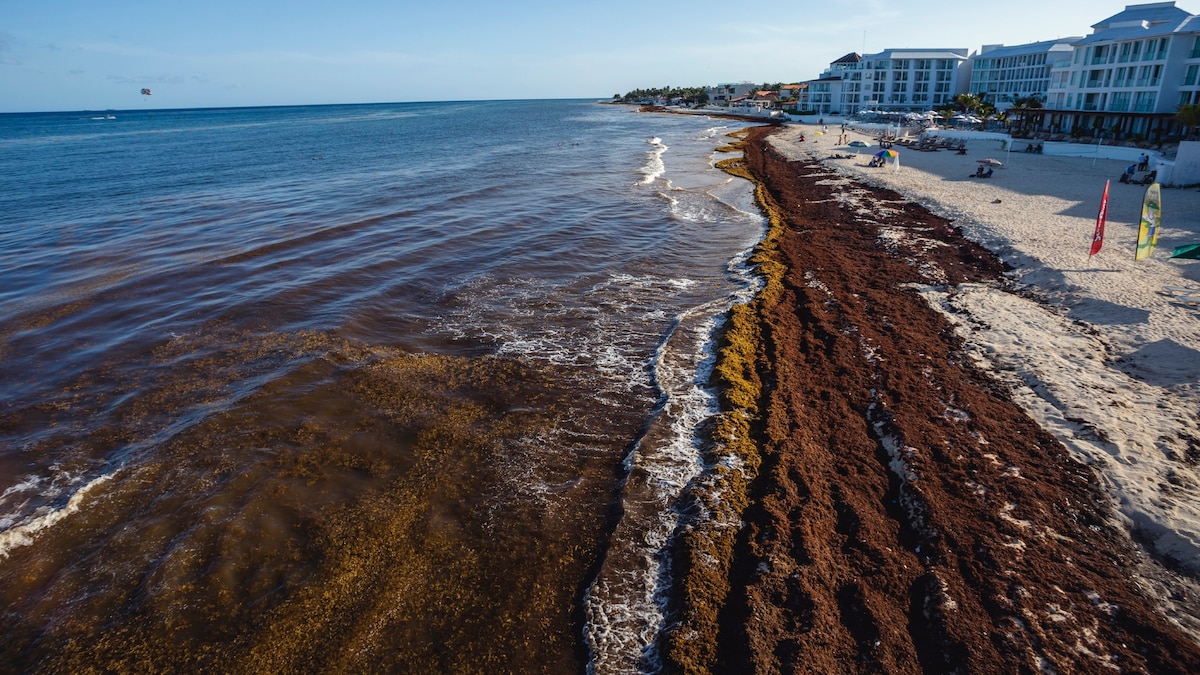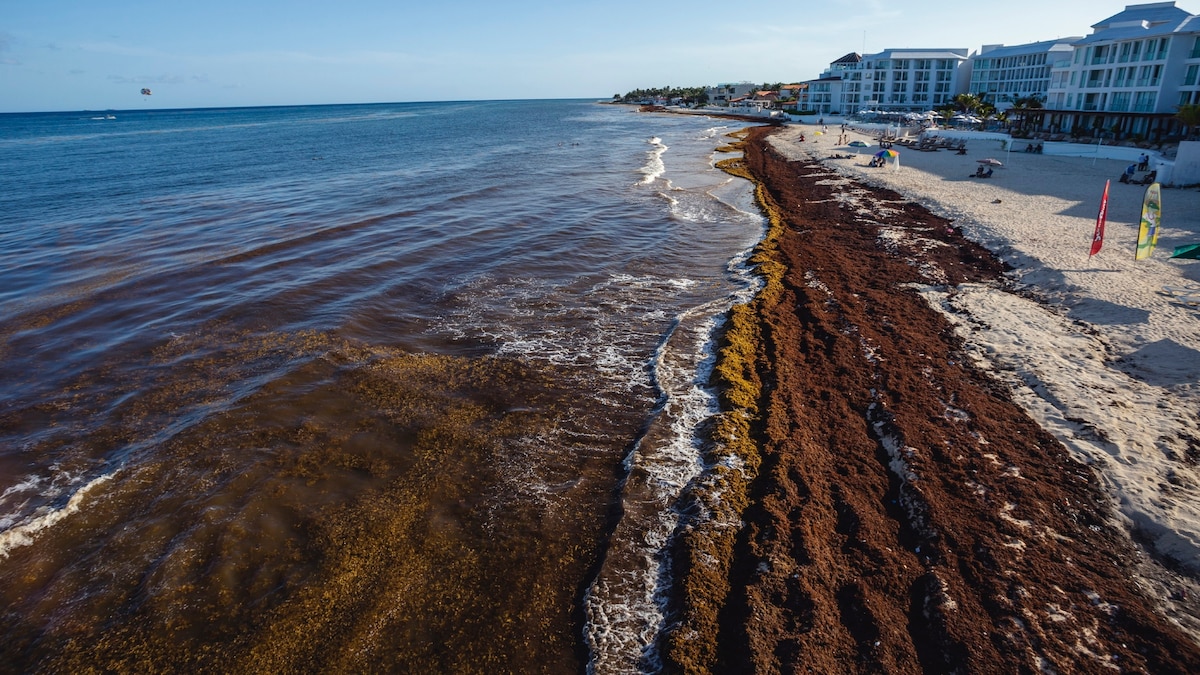
With their palm tree-fringed stretches of golden sand assembly clear blue sea, the seashores of Caribbean Mexico are recognized for being postcard-pretty. However now, within the spring and summer season, the Yucatán shoreline between Cancún and Tulum is clogged with mountains of seaweed, fouling the seashore with a sulfurous scent of decay and making the water almost unswimmable.
This macroalgae is known as sargassum, and it’s inflicting hassle in paradise.
The algae’s progress is cyclical and even useful in regular quantities. Normally the seaweed blooms and stays out within the ocean, offering a floating habitat for fish, shrimp, eels, turtles, and birds. “This can be a crucial habitat—it’s typically referred to as the ocean’s ‘golden forest’” says Chuanmin Hu, a professor of Optical Oceanography on the College of South Florida.
However the seaweed now includes the world’s largest algae bloom—and isn’t staying out within the ocean. Since 2011, huge portions have washed up on Caribbean coastlines, from the Lesser Antilles to Mexico’s Yucatán peninsula. Within the open ocean, huge rafts of it preserve daylight from reaching coral reefs; because it decays, the seaweed releases compounds that hurt marine life. The issue is sprawling: scientists utilizing NASA satellite tv for pc information not too long ago clocked the floating seaweed belt at 5,549 miles lengthy.
A employee removes sargassum from the seashore close to Tulum in Quintana Roo State, Mexico, in Might 2019. Accommodations and resorts alongside the coast make use of full-time staff (and spend hundreds of {dollars}) making an attempt to cease the seaweed from piling up on shore.
{Photograph} by Daniel Slim, AFP/Getty Photos
Please be respectful of copyright. Unauthorized use is prohibited.
As soon as on shore, sargassum piles stop sea turtles from laying eggs and reaching the ocean. Plus, it stinks, inflicting complications and nausea amongst beachgoers.
Scientists chalk the explosive progress as much as elevated runoff of agricultural inputs and sewage from the Amazon River in Brazil in addition to warming water temperatures and upwelling within the jap Atlantic Ocean.
For the reason that disaster started a decade in the past, the quantity of seaweed washing ashore has ebbed and flowed. “Sargassum season” sometimes blankets seashores from April to August. Some years, as in 2018, have seen significantly giant blooms, and 2021 is shaping as much as be “one of many file years,” says Hu. “This isn’t episodic—that is now regular.”
It’s an financial disaster in addition to an ecological one. In Mexico’s Quintana Roo state, the place tourism accounts for 87 p.c of the state’s GDP, extra sargassum poses an particularly pressing risk to livelihoods. So what, if something, can cease it?
An ecological downside with financial affect
Over two million passengers handed by means of the Cancún Worldwide Airport in June 2021, the very best quantity since February 2020. Alongside Mexico’s Riveria Maya, occupancies have returned to pre-pandemic ranges, due partly to the nation’s lack of COVID-19 restrictions on vacationers. However sargassum could once more deter guests. “Pre-COVID, sargassum positively impacted bookings,” says Zach Rabinor, CEO of tour company Journey Mexico. “It was a continuing headwind.”
After the 2018 sargassum surge, occupancy charges at Riviera Maya motels declined by 2.87 p.c. To compensate, motels lowered costs, moved disgruntled vacationers to different properties, or supplied excursions of off-beach points of interest.
(Right here’s the place to search out the Yucatán’s greatest cenotes.)
Please be respectful of copyright. Unauthorized use is prohibited.
Please be respectful of copyright. Unauthorized use is prohibited.
Left: Mexican scientist Marta Garcia examines sargassum on the Institute of Marine Sciences in Puerto Morelos, Mexico. Researchers and companies are in search of methods to repurpose the seaweed, from utilizing it at as fertilizer to turning it into biofuel.
Proper: A lady hangs sheets of paper constituted of sargassum to dry in Cancún. The sheets will likely be made into notebooks, one in every of many merchandise (cleaning soap, sneakers, building bricks) that entrepreneurs hope can flip the scourge right into a money crop.
{Photograph} by Rodrigo Arangua, AFP/Getty Photos
That very same yr, motels between Cancún and Puerto Morelos to the south spent round $200,000 every on wages for seashore clean-up personnel and transporting seaweed to disposal websites. Many have additionally shelled out for specialised removing boats, which may price as much as one million {dollars} (U.S.), and for offshore sargassum boundaries that run $100 per linear foot. Rabinor estimates that “midsized motels with giant beachfronts are spending hundreds of {dollars} a day [on removal], if no more, throughout peak moments.”
Journey agent Mallory Jones visited the Riviera Maya in Might 2021. Staffers at her resort labored to maintain the seaweed cleared, however she says the efforts had been “no match for Mom Nature.” Mounds of sargassum stored her off the sand and thwarted her kayaking plans. “It was a bummer. I’d keep away from that point of yr for private journey,” she says. Now, for shoppers “who really need a good seashore and clear water, I steer them away from Mexico altogether. It’s simply too unpredictable.”
Elimination by rake, tractor, or boat
Eradicating or deflecting kilos and kilos of seaweed, which generally washes in with each wave, isn’t only a matter of scooping the stuff up in a bucket and throwing it out.
The offshore seaweed boundaries use netting or floating bumpers to catch or block sargassum. Boats outfitted with scooping mechanisms may also elevate plant matter out of the water, however they are often costly. “Only some motels have these boats,” Rosa Rodríguez-Martínez, a researcher on the Universidad Nacional Autónoma de México, who has studied sargassum since 2015. “Most use the boundaries to deviate the algae to ‘sacrifice spots’ and use mechanical bands or bulldozers to add the algae to vehicles.”
Some motels get rid of sargassum on close by land, whereas others take it to disposal websites within the jungle. “Not one of the disposal websites, nevertheless, have been adequately ready to keep away from leachates [contaminated liquids] from reaching the aquifer,” Rodríguez-Martínez provides.
Two years in the past, President Andrés Manuel López Obrador enlisted the Mexican navy to assist cease the tide of seaweed earlier than it hit the shoreline. Navy boats, manned by 300 personnel, now harvest sargassum from boundaries put in at sea. As of Might 2021, they’d collected greater than 10,000 tons of it.
It’s a large effort. However the seaweed simply retains coming.
Staff take away sargassum from a Playa del Carmen seashore makes use of rakes and a tractor. The seaweed has been blanketing seashores in Mexico’s Yucatán since 2011.
{Photograph} by Bénédicte Desrus, Sipa USA/AP
Please be respectful of copyright. Unauthorized use is prohibited.
From scourge to money crop?
For now, in accordance with scientists, the one method to cease the sargassum would want to start upstream, says Rodríguez-Martínez. “Nations want to scale back the vitamins dumped into the ocean and take actions to mitigate local weather change.” However with Brazil persevering with to transform rainforests into fertilizer-demanding farms, the blooms could also be right here to remain.
(Right here’s the best way to go to Holbox, Caribbean Mexico’s idyllic, car-free island.)
Scientists are investigating different makes use of for the seaweed. Plant microbiologist Jaya Jayaraman and his crew on the College of the West Indies in Trinidad & Tobago have used sargassum to create a biostimulant for farmers that works much less like conventional fertilizer and “extra like a medication that helps the plant develop,” Jayaraman says. His lab can also be attempting to transform sargassum into compost and building supplies. In 2020, biochemical researchers on the universities of Exeter and Tub pioneered a salt-based biochemical conversion technique that would assist flip sargassum right into a biofuel.
Different corporations are discovering sustainable, business makes use of for sargassum. Puerto Rican biomanufacturer C-Combinator turns seaweed gathered in Quintana Roo into plant-based leather-based, cosmetics, and agricultural inputs. On the Playa del Carmen, BioMaya companions with girls in native Mayan villages to transform processed algae into cleaning soap that’s offered to hospitals and motels.
“By creating extra high-end or high-demand merchandise from seaweed, we are able to incentivize its harvest,” says C-Cominbator’s Jorge Vega Matos.
Annalise Jolley is a California-based journey author. Observe her on Instagram.


